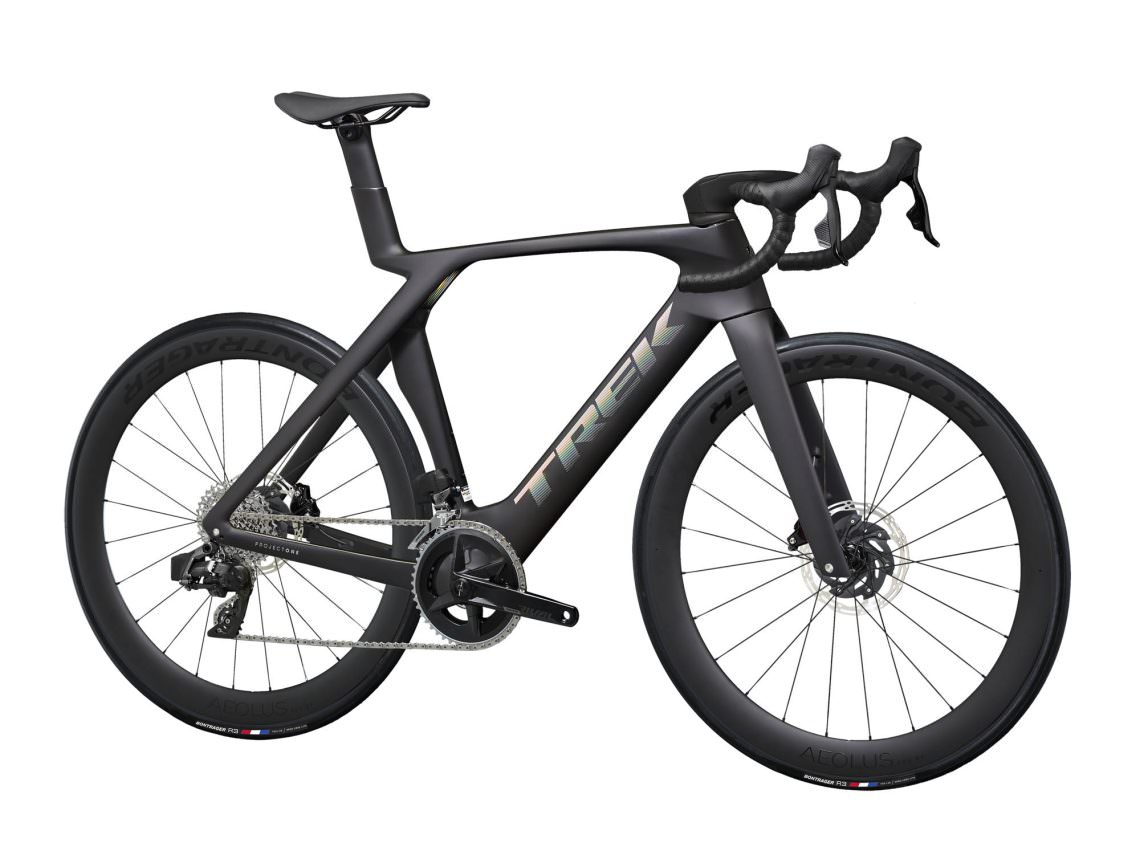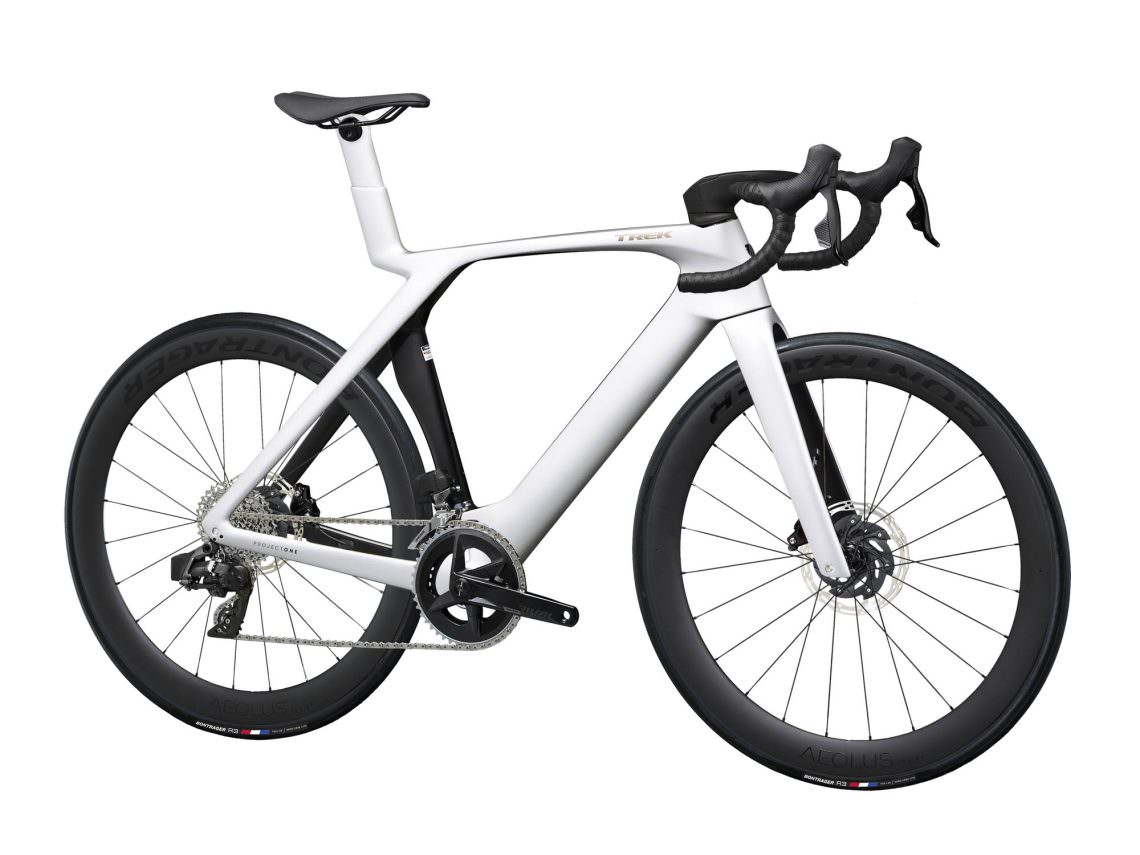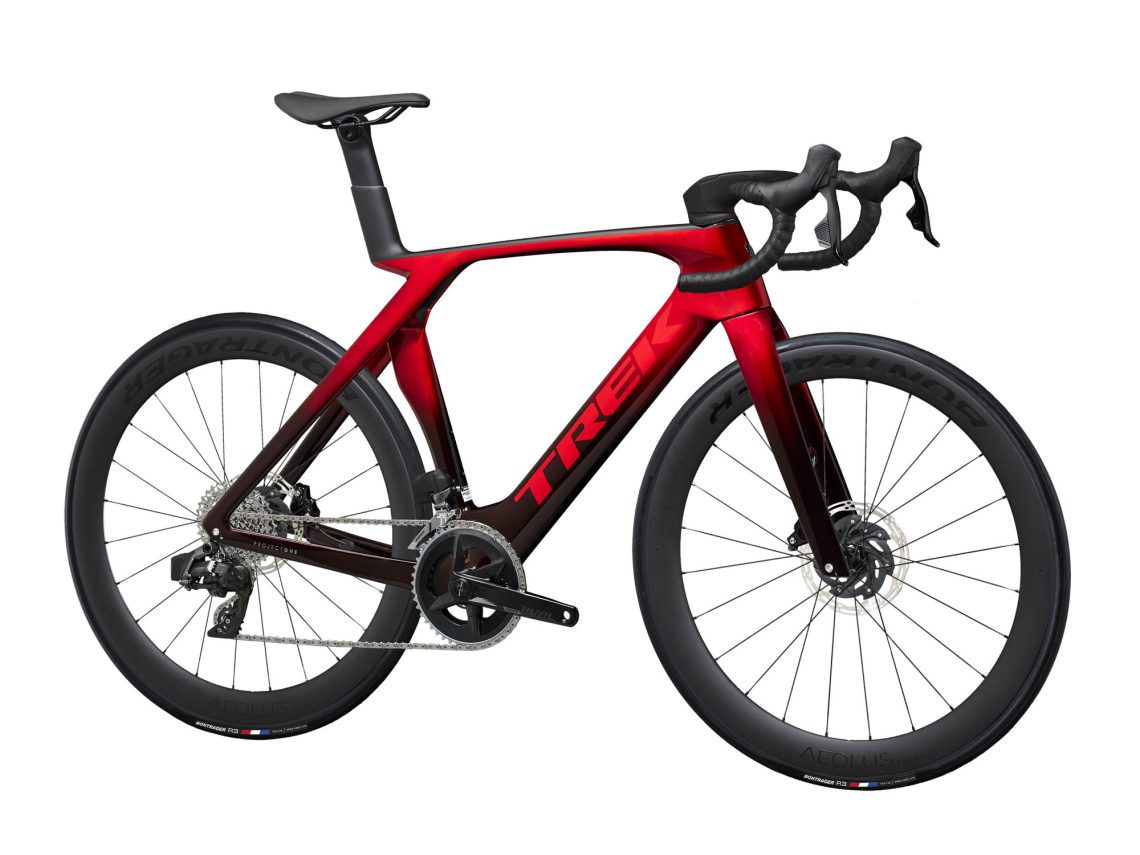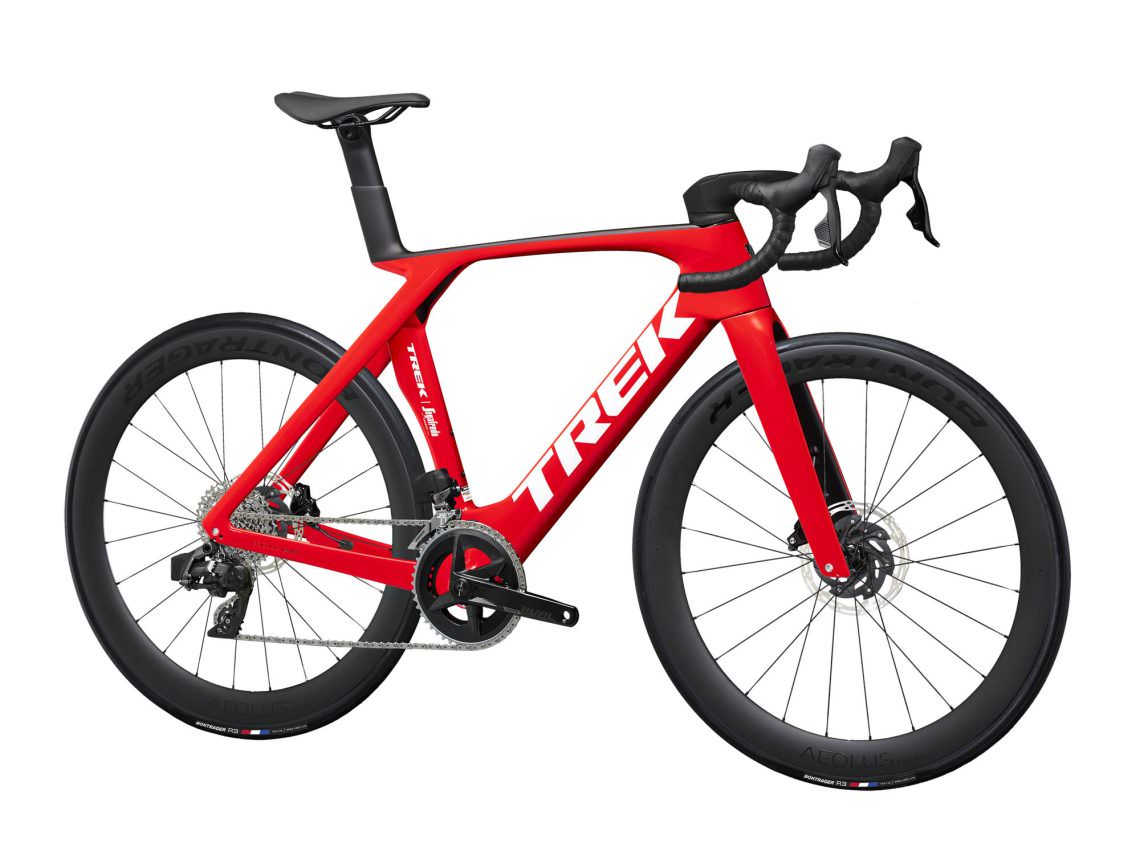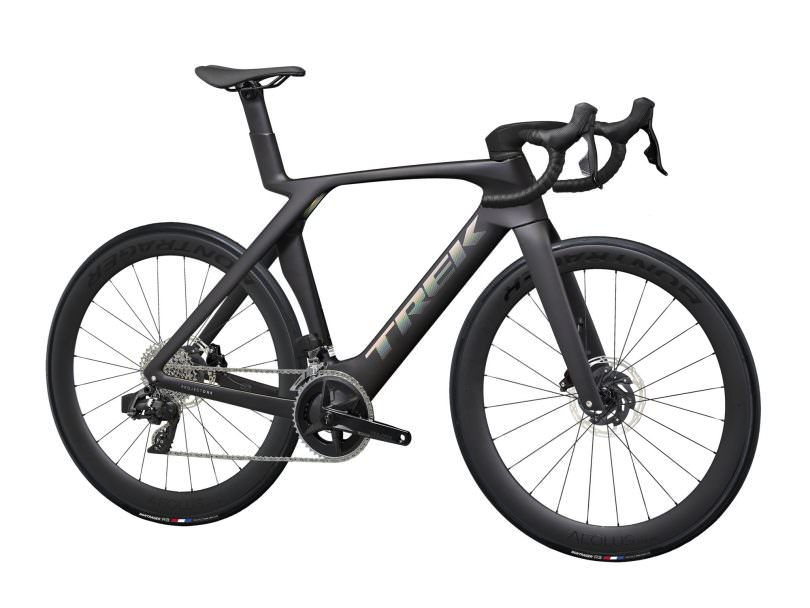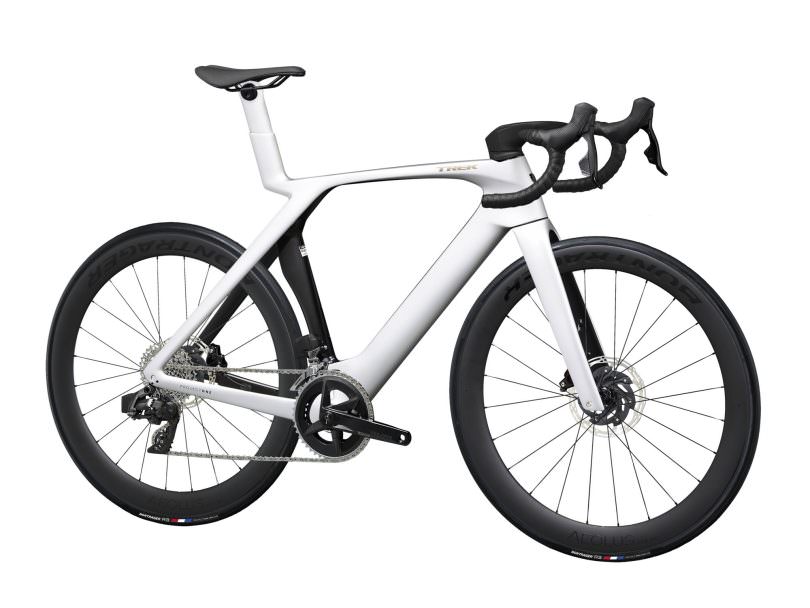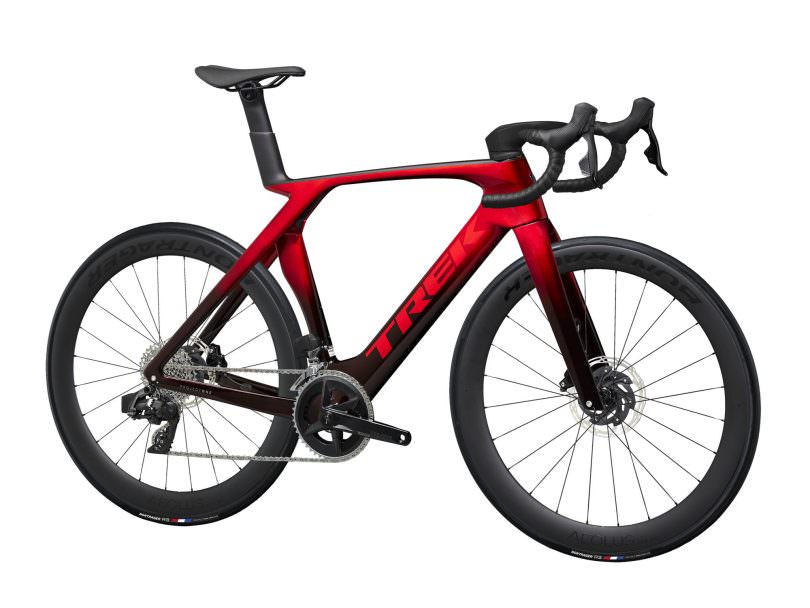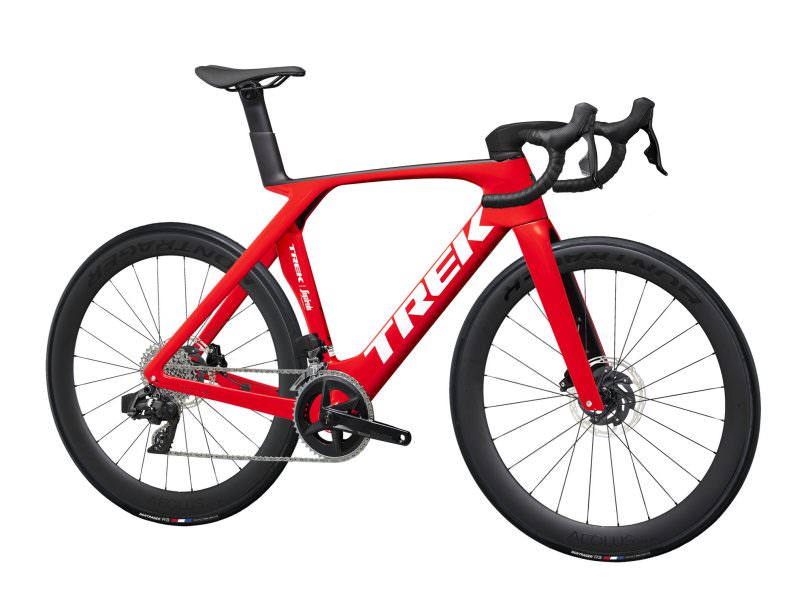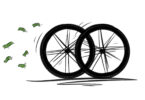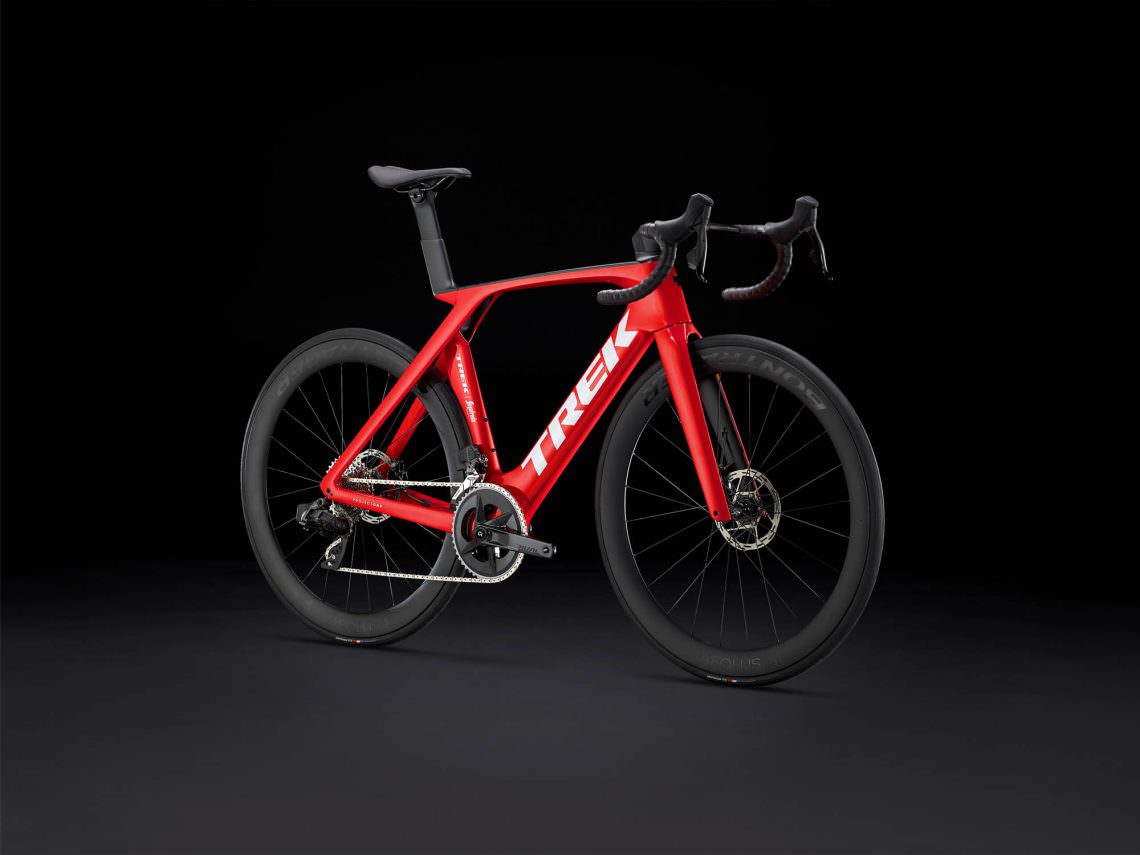
Radical design, new technologies, one goal: the 7th generation 2023 Madone SLR Disc is all about speed, promising to be the fastest bike Trek have made to date. On the new model, the IsoSpeed system has been replaced with the all-new IsoFlow technology. Read on for all the details on the new aero bike.
Wow, what a machine! From the moment we saw the first photos of the 2023 Trek Madone SLR Disc at the Critérium du Dauphiné make the rounds on the internet, the online community was in uproar. The reactions ran the gamut from “that’s definitely a mad one” all the way to “at first I thought it was a joke, sadly it wasn’t.” There was lots of speculation but now we’ve finally got the official details! Fact: the 2023 Trek Madone SLR Disc is more than just a looker with its radical design and all-new IsoFlow system. The American brand promise a lot of advantages with this new design, ironing out some of the weaknesses of its predecessor. Below, we’ve made a summary of the most important changes and details regarding Trek’s new race weapon.
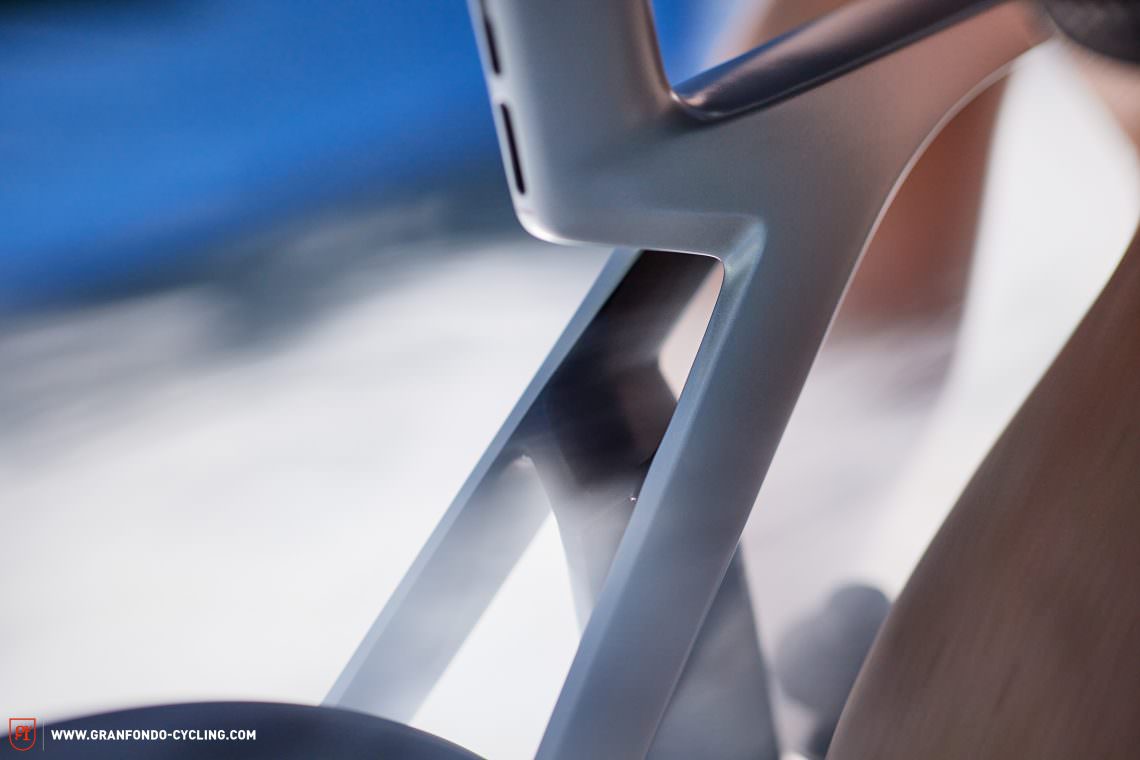
The new IsoFlow system in detail
IsoFlow is what Trek are calling the new damping and aerodynamic system of the 2023 Madone SLR Disc, which is here to replace the tried and trusted IsoSpeed system that they’ve developed over the years. The previous system was relatively heavy and complex, which is why the team riders often questioned its usefulness. So, the engineers at Trek got to work, finding out where they could save the most weight and make the biggest performance gains. The solution: IsoFlow. The new system promises improved aerodynamics and comfort while saving weight and time. Over a 60-minute stretch at 45 km/h, the 2023 Trek Madone SLR is claimed to be a minute faster than its predecessor.
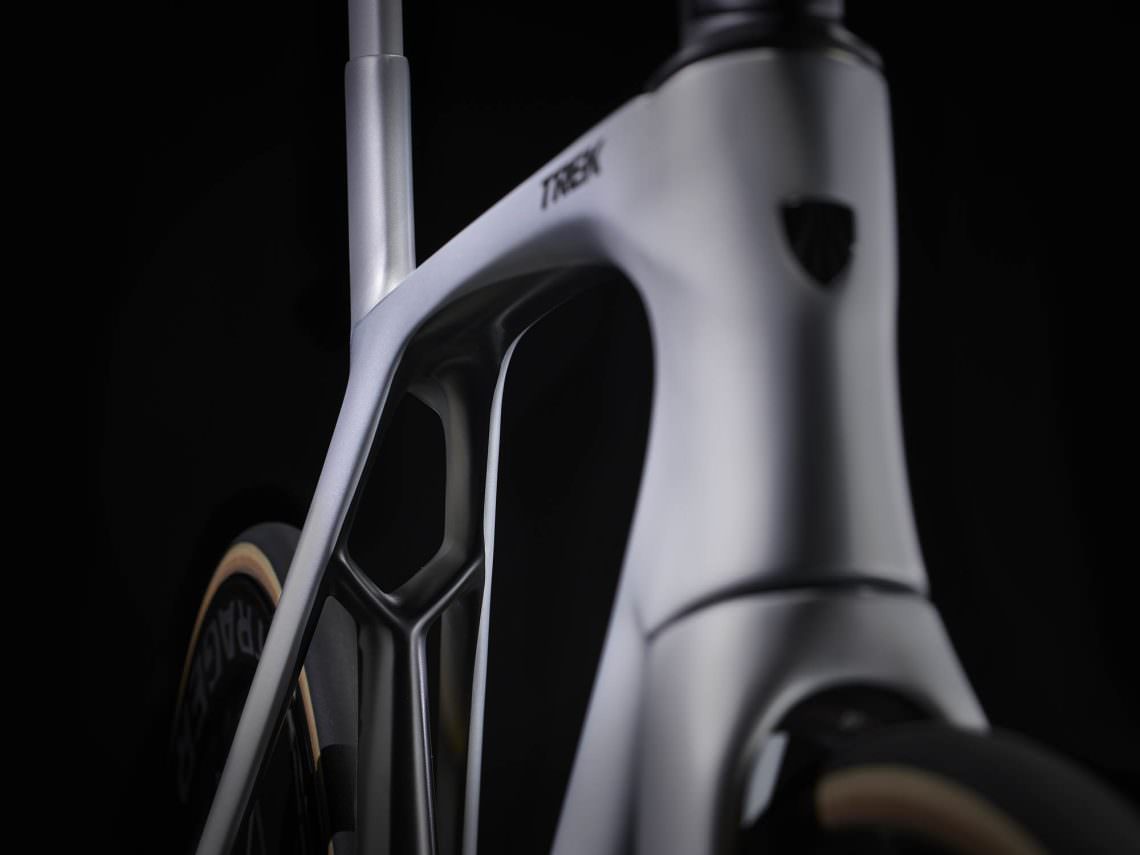
The IsoFlow system is comprised of the top section between the seat stays, leaving a gap in the seat tube. The diamond-shaped window should allow for better airflow, thereby improving aerodynamics while also adding comfort. By interrupting the seat tube, the seat mast and the top tube should have more vertical compliance. As such, the all-new frame promises a good balance between stiffness and comfort, remaining stiff when you sprint yet still providing a comfortable ride. According to Trek, you only get vertical compliance where it’s needed, when sitting on the saddle.
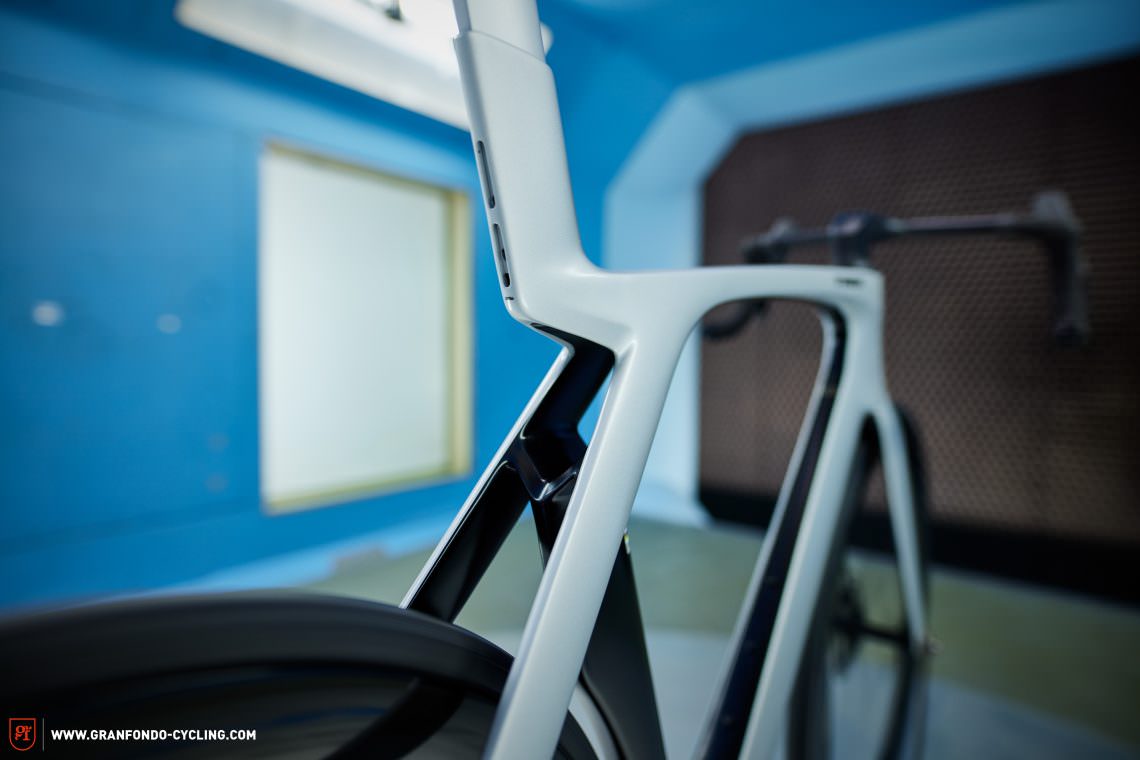
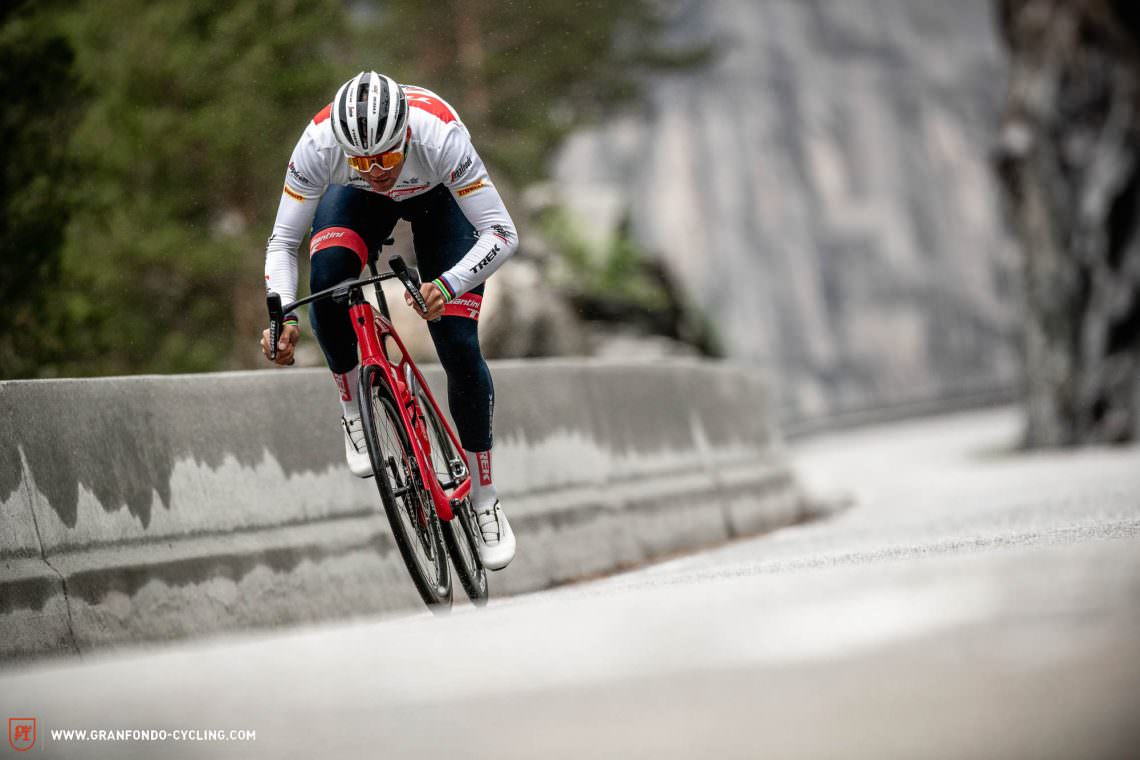
The IsoFlow system is a lot less complex than the old IsoSpeed design, though it can’t deliver the same level of compliance and comfort. This is good news for the more race-oriented Madone fans. However, those who loved the look and feel of the previous Madone will have to accept making a compromise on the latest generation model. We were always impressed with the old IsoSpeed system, but there’s no denying that it had its drawbacks. For one, the comfort between the front and rear felt imbalanced, which should no longer be the case with the 2023 Trek Madone SLR Disc. In a nutshell: better performance, better aerodynamics, less weight. And that at the cost of a little less, yet more balanced comfort. It all sounds good in theory.
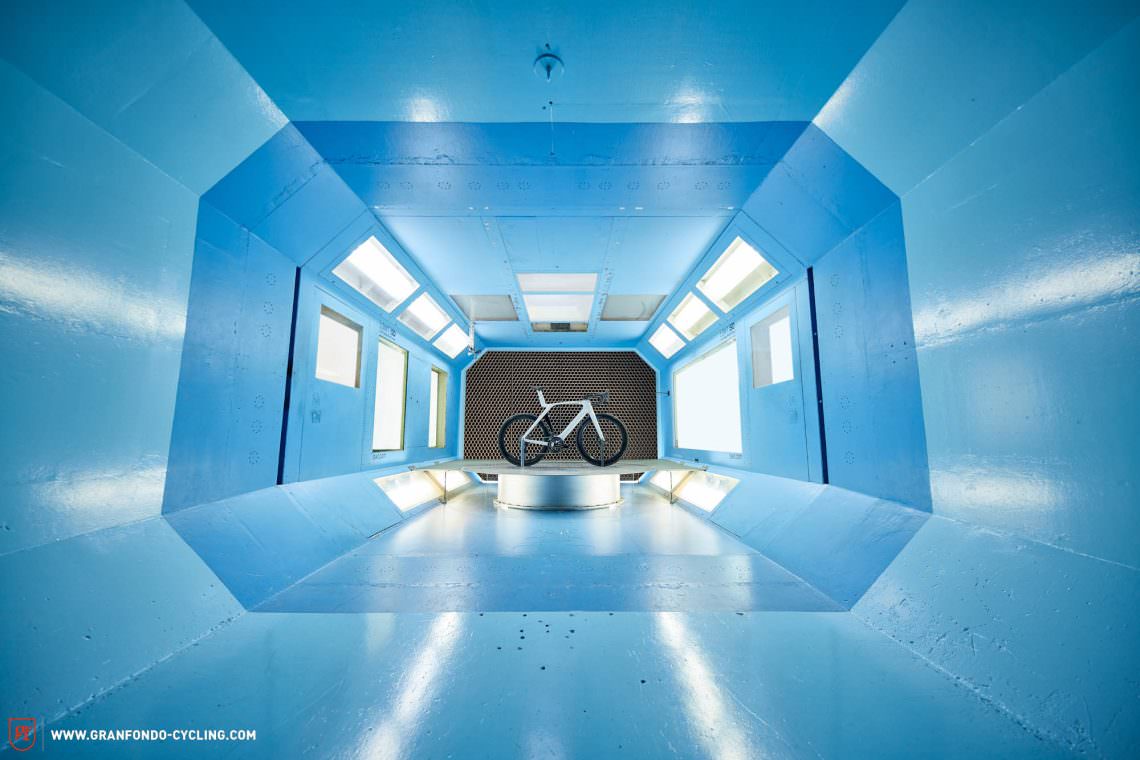
Improved aerodynamics on the 2023 Trek Madone SLR Disc
It’s not just through the new IsoFlow system that the aerodynamics of the 2023 Trek Madone SLR Disc have been improved, but also via the cockpit and therefore the position of the rider. The bike itself makes up the smallest proportion of wind resistance by far, with the rider generating about 75% of the total wind resistance from a speed of 15 km/h on a flat road. So, there are a lot of gains to be made by optimising the position of the rider. It’s for this reason that Trek claim to have included the rider in all the aerodynamic optimisations of the 2023 Madone. Doing so makes a lot of sense to us because the bike and rider always function as a unit. A lot of other brands focus solely on the bike when making aerodynamic optimisations, which results in misleading or even counterproductive results. The rider and their position on the bike causes disruptions to the airflow, changing the way it interacts with the bike ultimately costing time or watts.

The handlebar has been designed specifically for the Madone, putting the rider into a particularly aerodynamic riding position. Its width is measured at the drops, with the top section being 3 mm narrower. To make the most of the aerodynamic improvements, you shouldn’t opt for a wider handlebar.
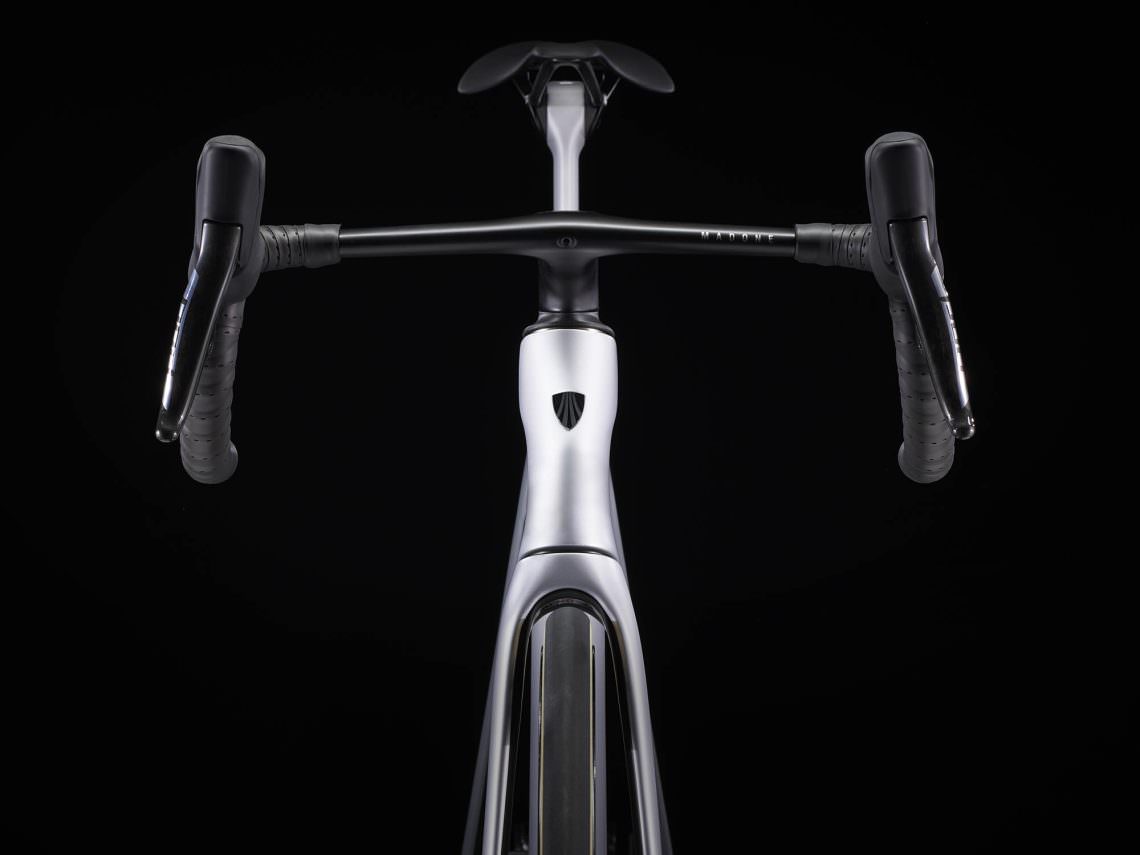
In the drops, the slightly flared design gives you more control of the bike while also improving your performance thanks to the superior aerodynamics of that position. According to Trek, it channels the airflow over the rider’s thighs in an optimal fashion. They even took the water bottles and derailleurs into consideration and the enlarged area around the bottom bracket supposedly adds a further aerodynamic advantage.
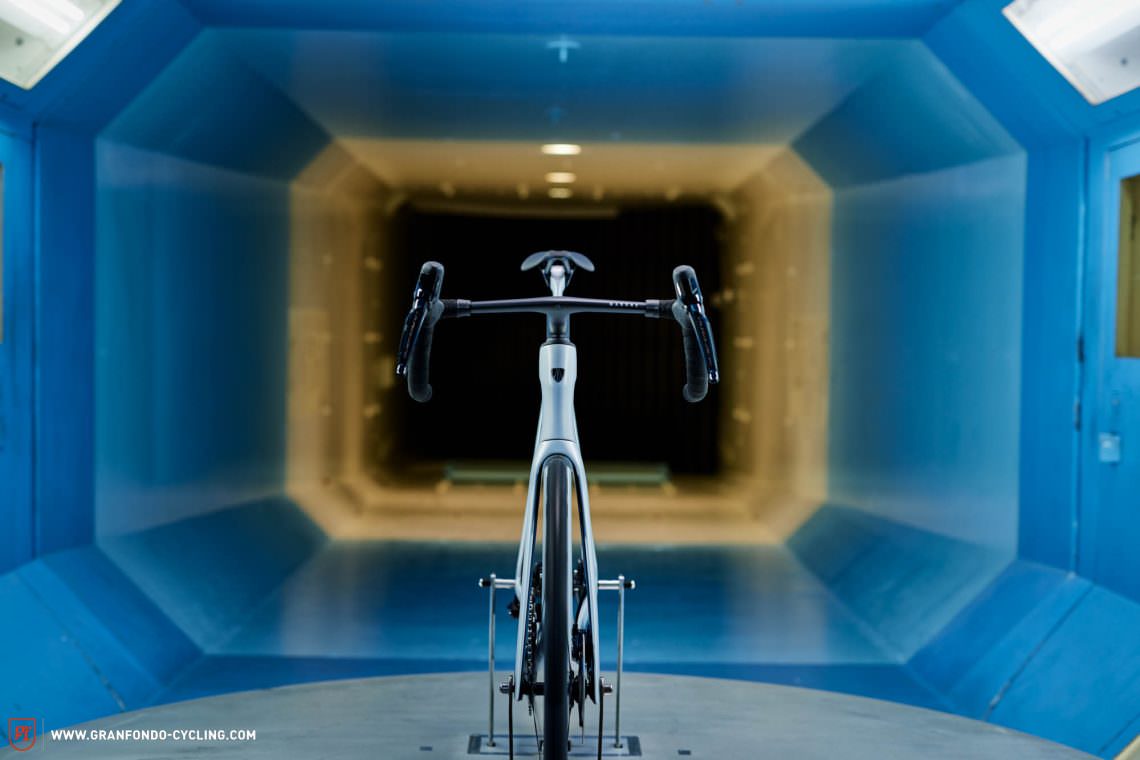
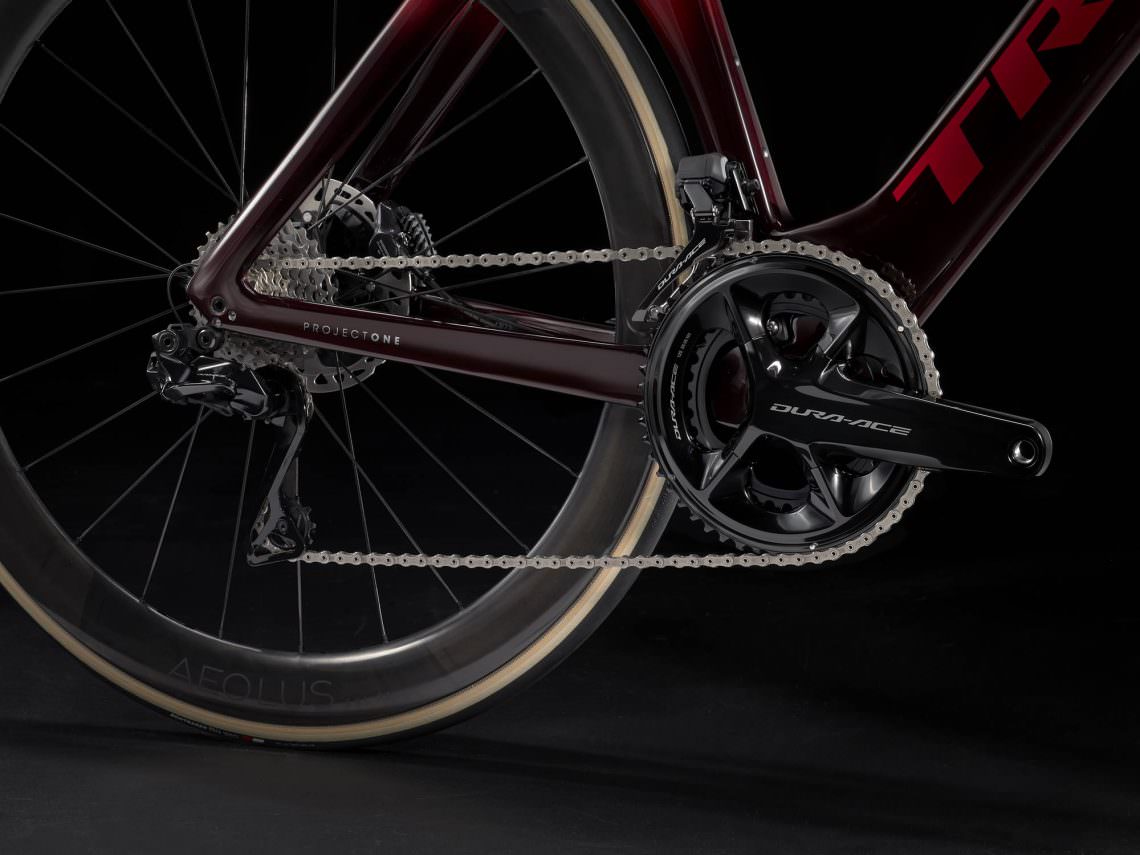
Trek have attempted to quantify the promised gains. Accordingly, the American brand claim to save 9.3 Watts thanks to the bike’s improved dynamics, i.e. the new IsoFlow system, improved tube shapes and cockpit design (without the rider). The gains achieved by optimising the rider’s position – mainly via the new cockpit – are even bigger, saving you an additional 9.7 Watts. That gives you a total saving of 19 Watts at 45 km/h. All these values are relative to the previous Madone.
Weight optimisation – How much lighter is the 2023 Trek Madone?
The SLR 9 with the eTap groupset weighs in at just 7.4 kg in size 56, making the 2023 Madone SLR Disc the lightest Madone Disc on the market. In total, Trek say they’ve shaved off 300 g compared to the predecessor, which is quite a chunk. Last year’s Madone SLR 9 eTap weighs 7.65 kg (review here). We’re told that the weight optimisations apply to the bike as a whole. As such, the American brand claim that it makes a big difference where they’ve taken material away, adding flex at specific spots to achieve the desired compliance. The 2023 Trek Madone SLR Disc relies on oversized tubes that are light, stiff and aerodynamic, nonetheless. Like the predecessor, the 2023 Trek Madone SLR is made of OCLV 800, which is their highest grade carbon.
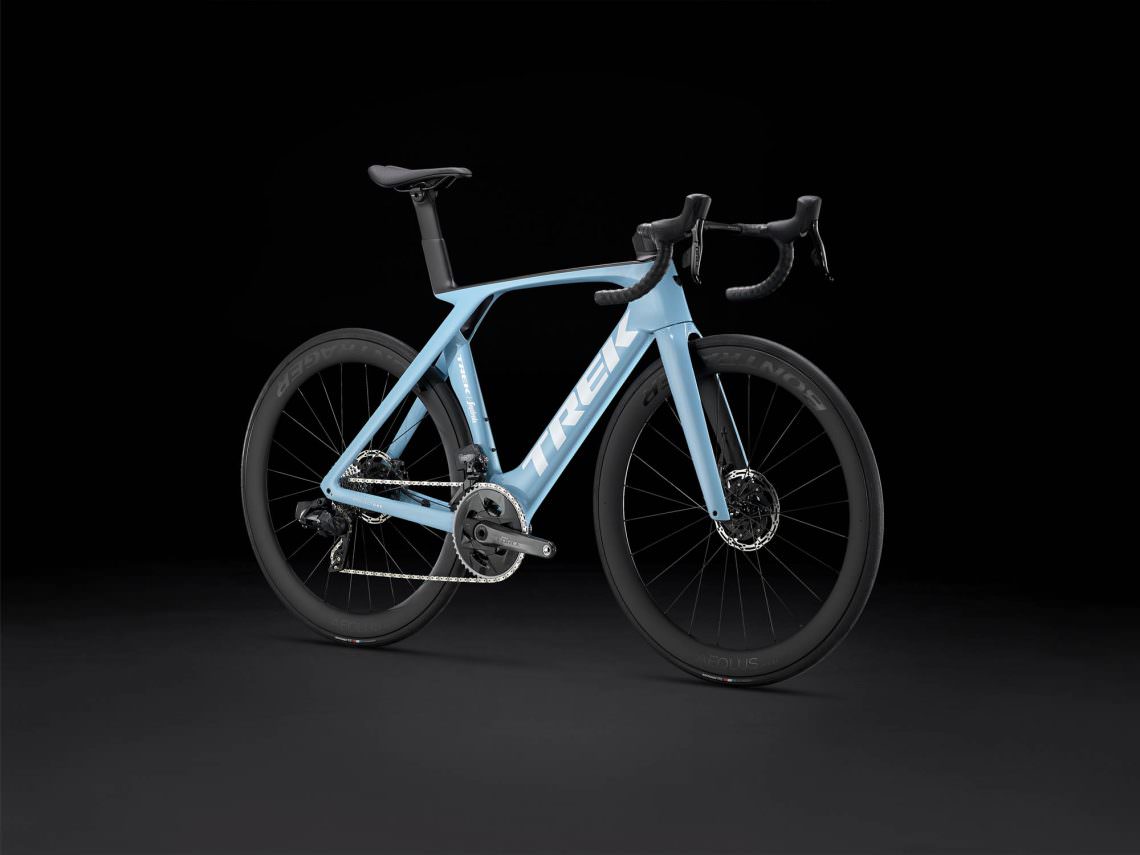
Of course, a large part of the weight savings is down to the new IsoFlow system. Trek say they’ve saved about 50% on the cockpit and frame. Despite all their efforts, however, the Emonda SLR 9 (review here) remains the lightest bike in their portfolio, weighing in at just 6.86 kg. It’s just not their most aerodynamic option. Despite this, we’re sure to see the pros opting for the lighter Emonda on the big mountain stages.
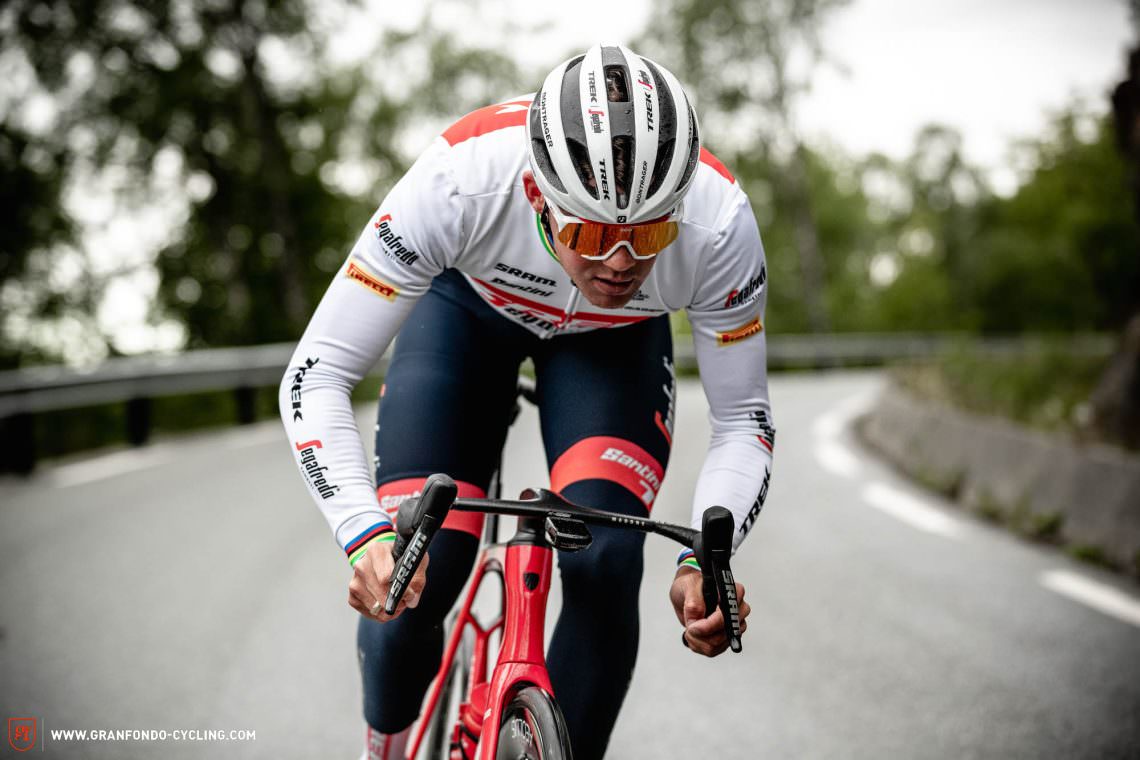
The 2023 Trek Madone SLR in detail and the available models

The 2023 Madone SLR Disc will be available in 6 different models with prices ranging from € 7,699 to €14,999. If none of the standard models meet your demands, you can let your creativity run wild in Trek’s Project One configurator. The 2023 Madone Disc will be offered with Shimano’s 105 R7170 (yes, you read that right, Shimano’s 105 Di2 groupset is officially here), ULTEGRA R8170 and DURA-ACE R9270 Di2 groupsets.
Those who prefer SRAM can choose between the Rival eTap AXS, Force eTap AXS and the RED eTap AXS groupsets, the latter of which is what Team Trek Segafredo are running. All the SRAM-equipped models also come with an integrated power metre in the cranks. Only the SL models will be available with mechanical groupsets. Moreover, the SL models will continue to rely on the old IsoSpeed system, combined with a different carbon layup. As such, the new IsoFlow technology is exclusive to the SLR range.
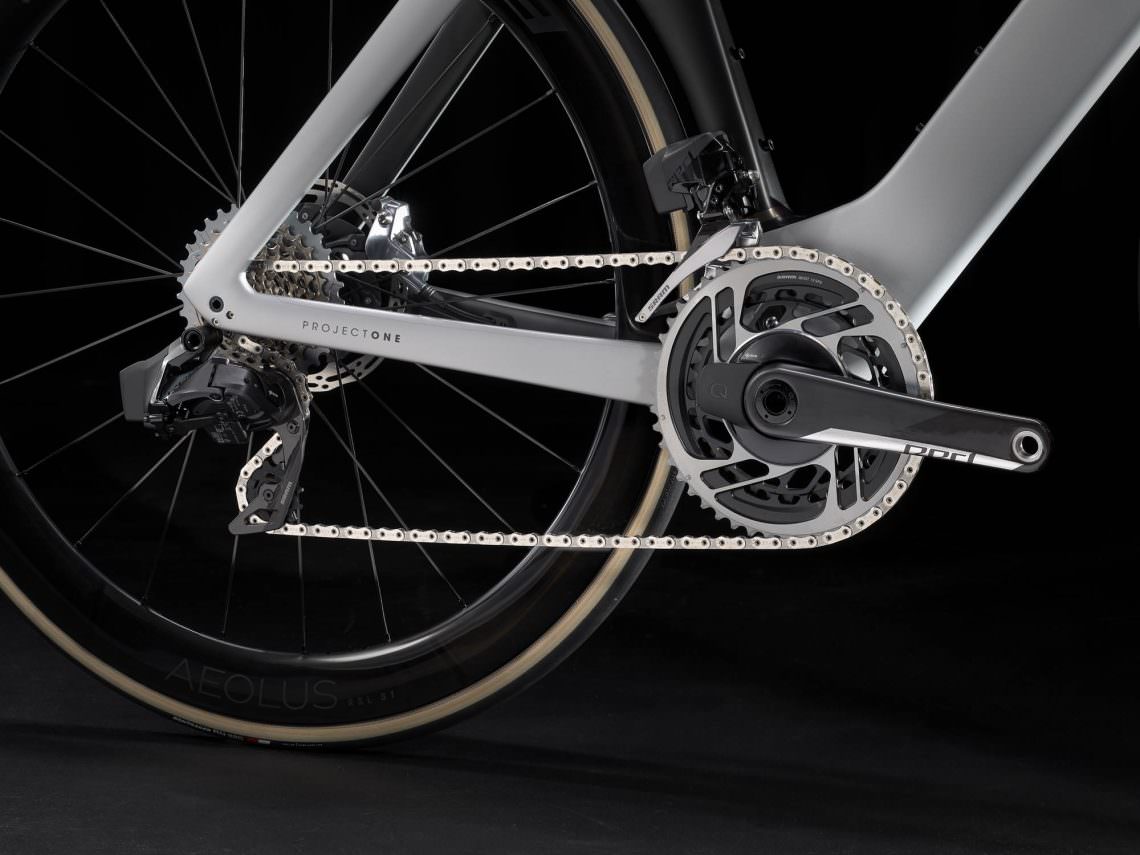
Supplied in-house, the 25 mm Bontrager R3/R4 tires keep it all grounded. These are fitted to Bontrager Aeolus Pro/RSL wheels with a rim depth of 51 mm, which are tubeless-ready, though they come shipped with tubes installed. To convert the 2023 Madone to tubeless, all you’ll need is sealant, tubeless-ready tires, rim tape and TLR valves. Trek recommend a maximum tire width of 28 mm, which they say should give you 6 mm clearance around the tires. If you want to make the most of this clearance and fit wider tires, that’s up to you. However, doing so isn’t officially Trek-approved.
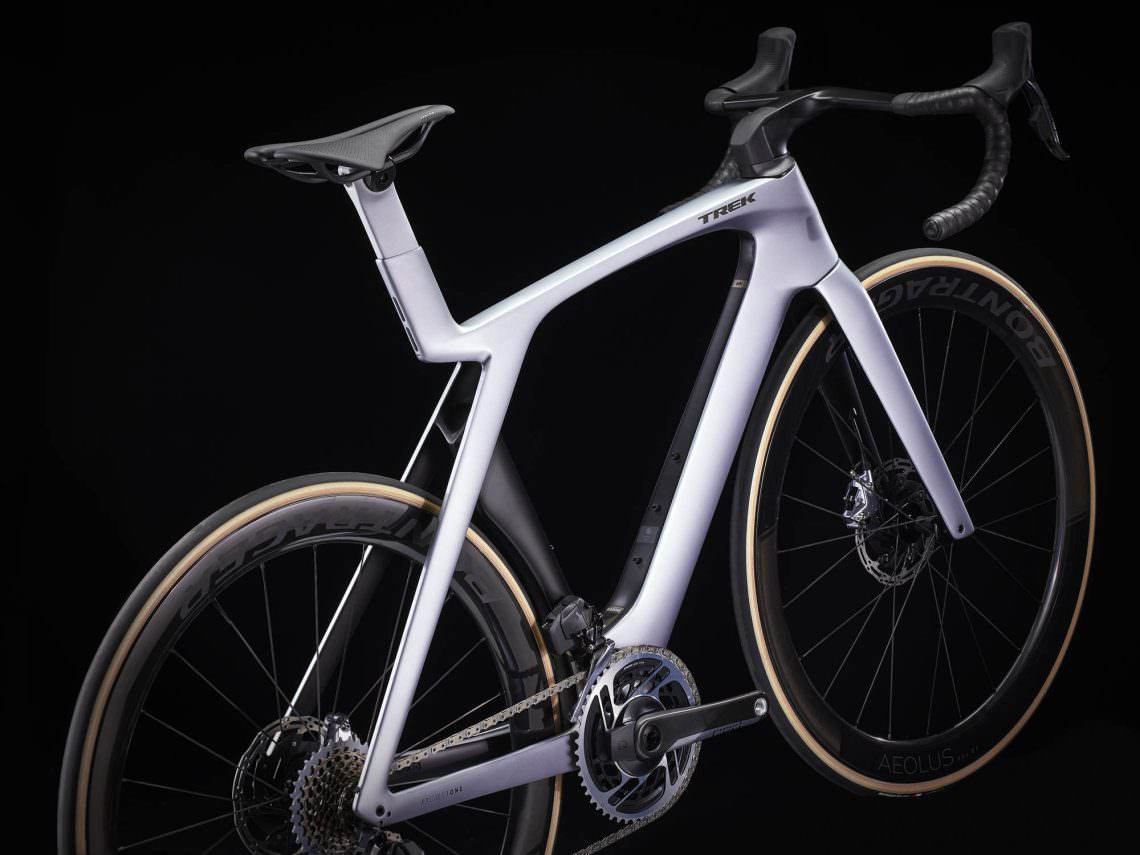
The seat post and handlebar are made especially for the 2023 Madone Disc. There are four different seat posts available. Frame sizes 47 to 54 come with the short seat post while sizes 56 to 62 come with a long version – these are needed since the seat mast offers a limited range of adjustability. Both seat post lengths have an adjustment range of 70 mm. By making the seat post clamp reversible, they were able to maximise the adjustment range. The seat post comes with a 0 mm offset as standard, though there’s a 20 mm offset version available, both of which are colour-coded to match the frame.
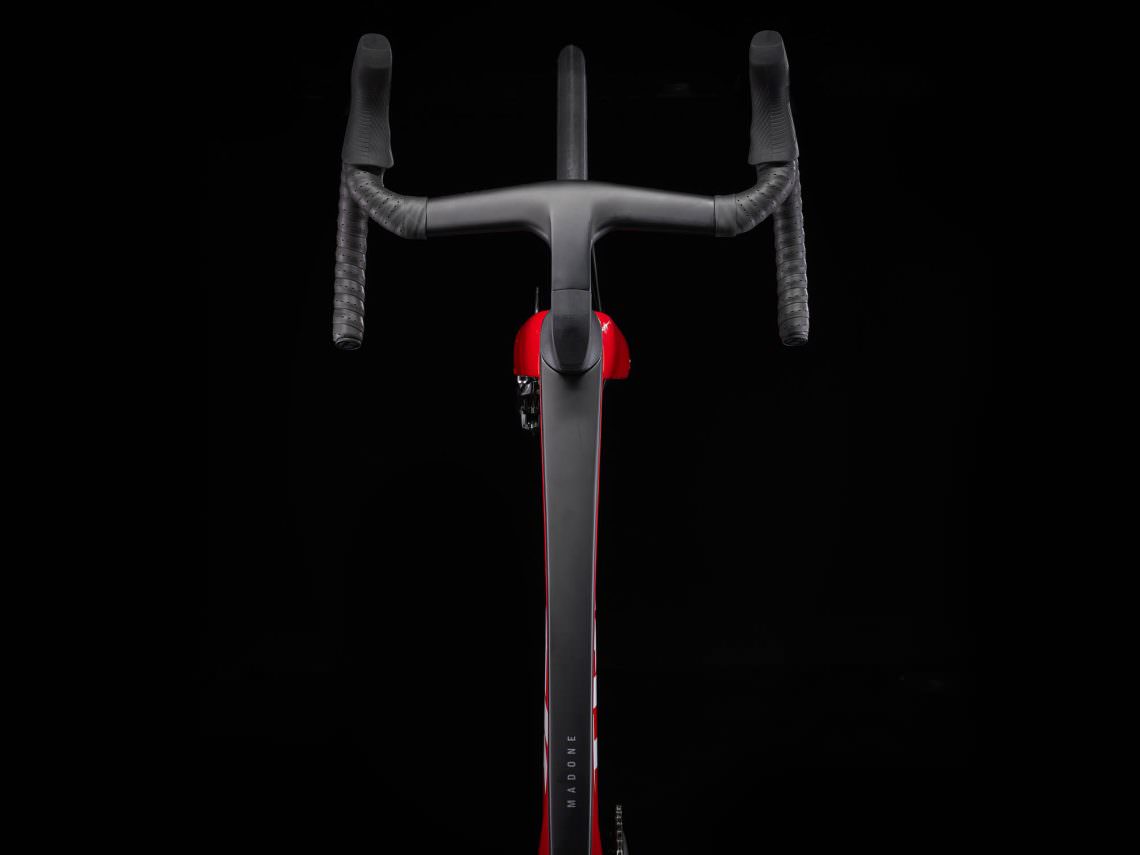
The cockpit of the 2023 Madone SLR Disc is made of one piece. For the best fit, Trek offer 14 different versions of it, which get specced according to the frame size or the customer’s preference. If you’re still not happy with that, you can fit any stem and handlebar combination you want, as long as it relies on a 31.8 mm clamp. All you need is a special headset cover.
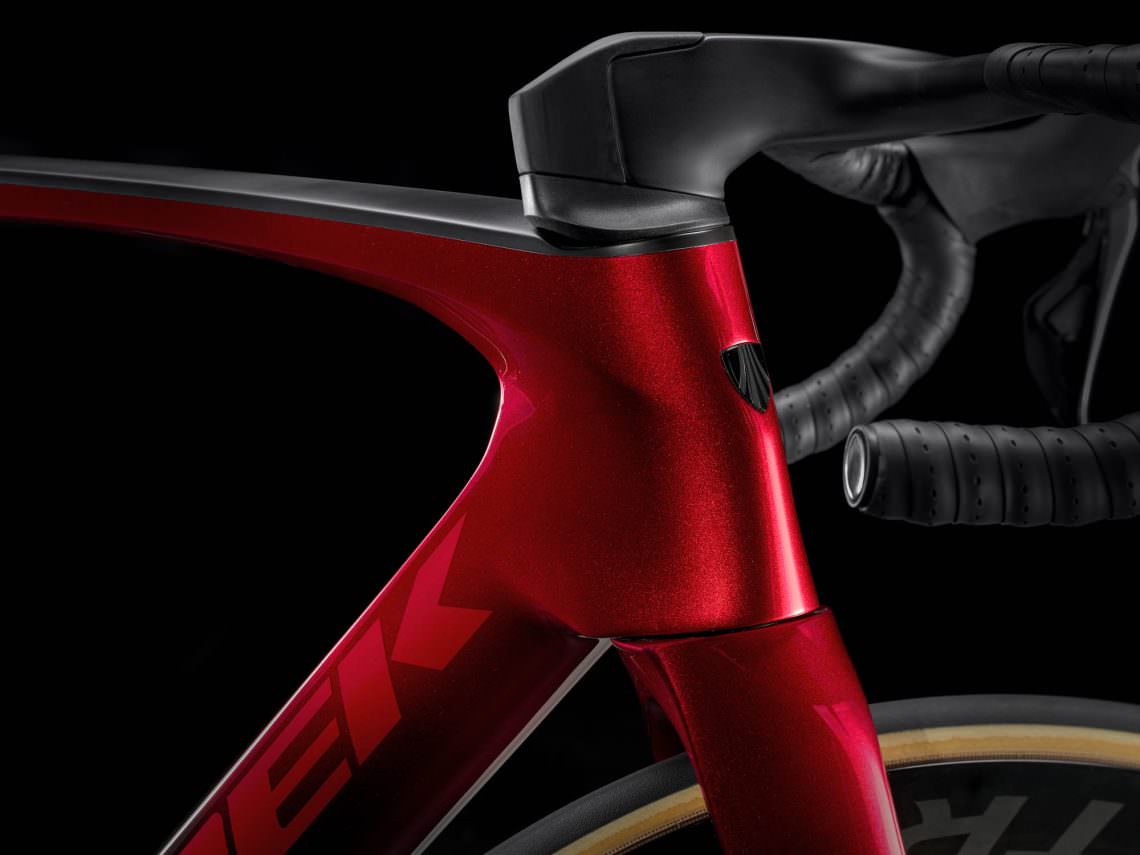
While the stock bike features a big 160 mm rotor at the front paired with smaller 140 mm rotors at the rear, you have the option of upgrading to a 160 mm version at the rear, too. Nothing has changed with regards to the cable routing, remaining almost completely hidden throughout. You can only see a short section of the brake lines peeping out on the fork and the chainstay just before they reach the callipers.
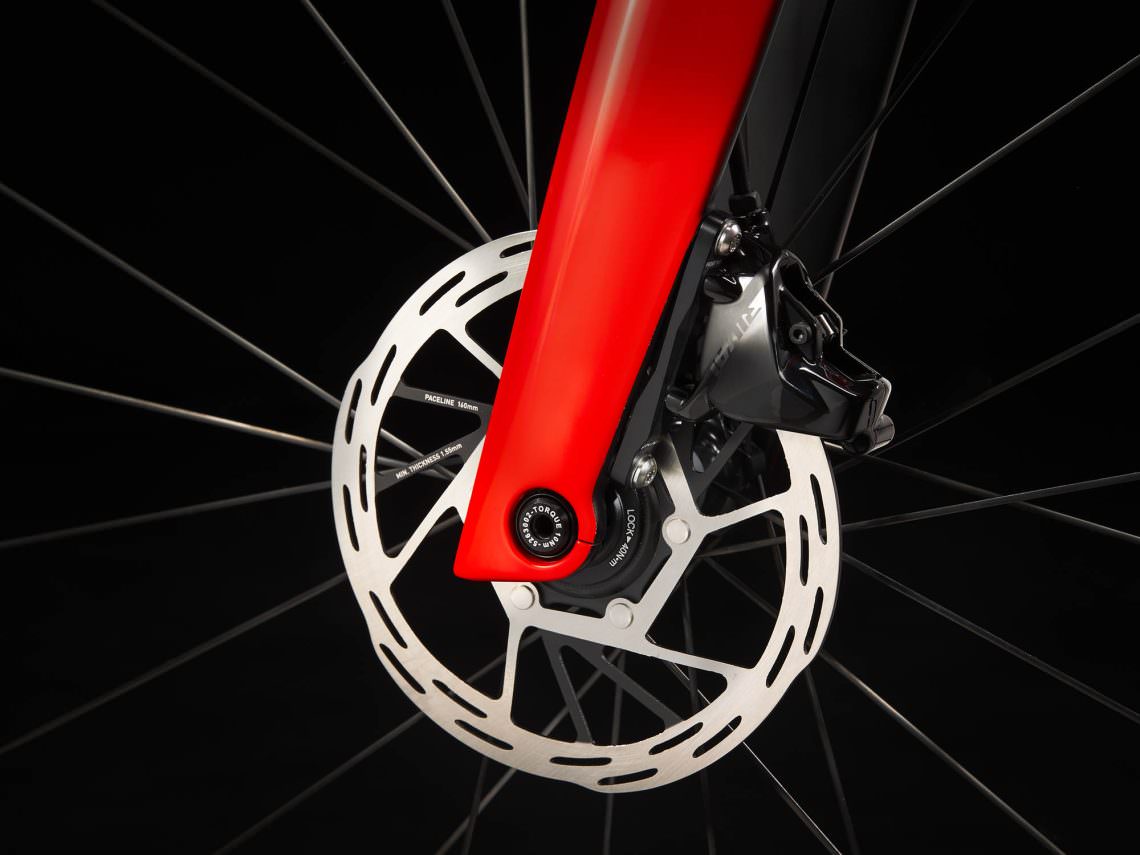
As before, the 2023 Trek Madone SLR Disc is compatible with Trek’s Blendr range of lights. There’s a front Blendr mount included with the bike. However, you’ll have to buy the mount for the Madone SLR seat post separately – we would have preferred it the other way around. After all, visibility to other road users is vital. Of course, if you’re going to be training or just riding day and night and in all conditions, it’s best to have both.
Since it’s reliable and easy to maintain, Trek remain true to the T47 bottom bracket standard. That said, the 2023 Trek Madone SLR Disc is also compatible with 30 mm crank axles. You just have to make sure that you’re using the correct bearings.
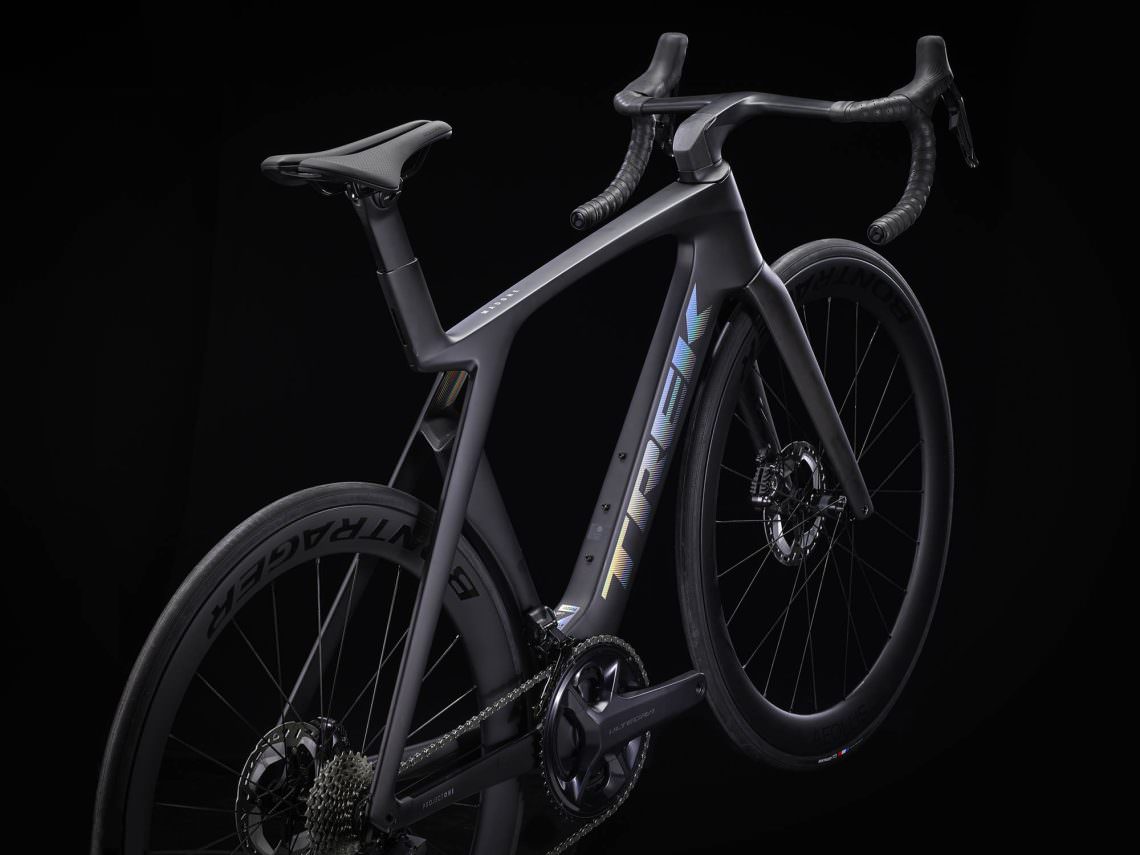
There are five standard colours to choose from, or you can let your creativity run wild in the Project One configurator. The new Madone is only expected to hit stores by September/October this year, but you can place your order now.
The geometry of the 2023 Trek Madone SLR Disc
As with the predecessor, Trek have gone with their race-oriented H1.5 geometry for the 2023 Madone SLR Disc, which they’ve paired with new tube shapes as well as IsoFlow technology for aerodynamic optimisation. It’s predominantly the handlebar that puts the rider in a more aerodynamic position since the only thing that they’ve changed on the geometry is the maximum and minimum seat post height. The bike will be available in Trek’s usual sizes, ranging from 47 to 62 cm.
| Size | 47 | 50 | 52 | 54 | 56 | 58 | 60 | 62 |
|---|---|---|---|---|---|---|---|---|
| Top tube | 512 mm | 521 mm | 534 mm | 543 mm | 559 mm | 574 mm | 586 mm | 598 mm |
| Head tube | 100 mm | 111 mm | 121 mm | 131 mm | 151 mm | 171 mm | 191 mm | 211 mm |
| Head angle | 72,1° | 72,1° | 72,8° | 73,0° | 73,5° | 73,8° | 73,9° | 73,9° |
| Seat angle | 74,6° | 74,6° | 74,2° | 73,7° | 73,3° | 73,0° | 72,8° | 72,5° |
| Chainstay | 410 mm | 410 mm | 410 mm | 410 mm | 410 mm | 411 mm | 411 mm | 412 mm |
| BB Drop | 72 mm | 72 mm | 72 mm | 70 mm | 70 mm | 68 mm | 68 mm | 68 mm |
| Stack | 507 mm | 521 mm | 533 mm | 541 mm | 563 mm | 581 mm | 601 mm | 620 mm |
| Reach | 373 mm | 378 mm | 383 mm | 386 mm | 391 mm | 396 mm | 399 mm | 403 mm |
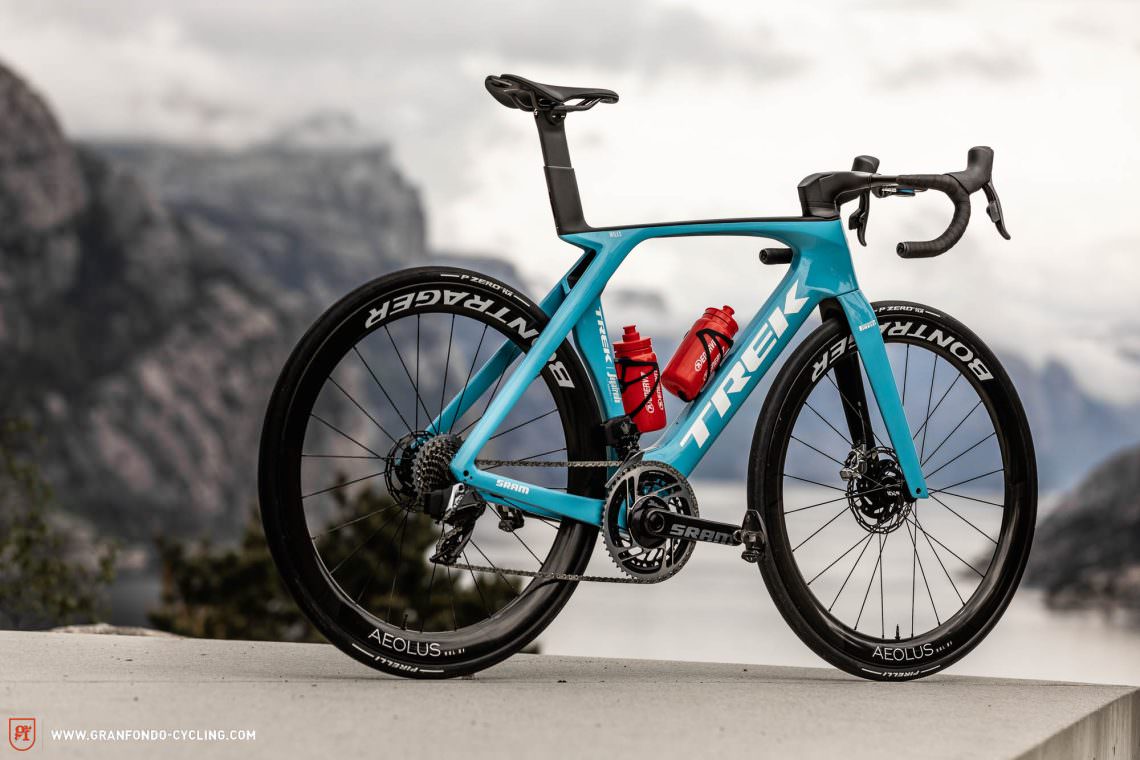
Who is the 2023 Madone for?
Whether a pro athlete or ambitious privateer, criterium or steep Alpine passes, the 2023 Madone Disc is aimed at those who are motivated to ride fast. Weekend warriors could ride the bike every day during the week and then pin a race number to their jersey at the weekend. Those who know Trek will know that the SLR range isn’t aimed at the masses, but rather at pros and all those who dream of being one – as long you’ve got the money. If you want to fly under the radar on your training rides, you’ll have a hard time doing so aboard the Madone with its polarising looks. It’s guaranteed to turn heads and start conversations at your local coffee stop. That’s exactly what some riders want, so it all depends on the type of rider you are.
Want that race feeling, but far away from traffic and asphalt? Then check out our review of the 2023 Checkpoint SLR 7 with its integrated storage compartment (available here).
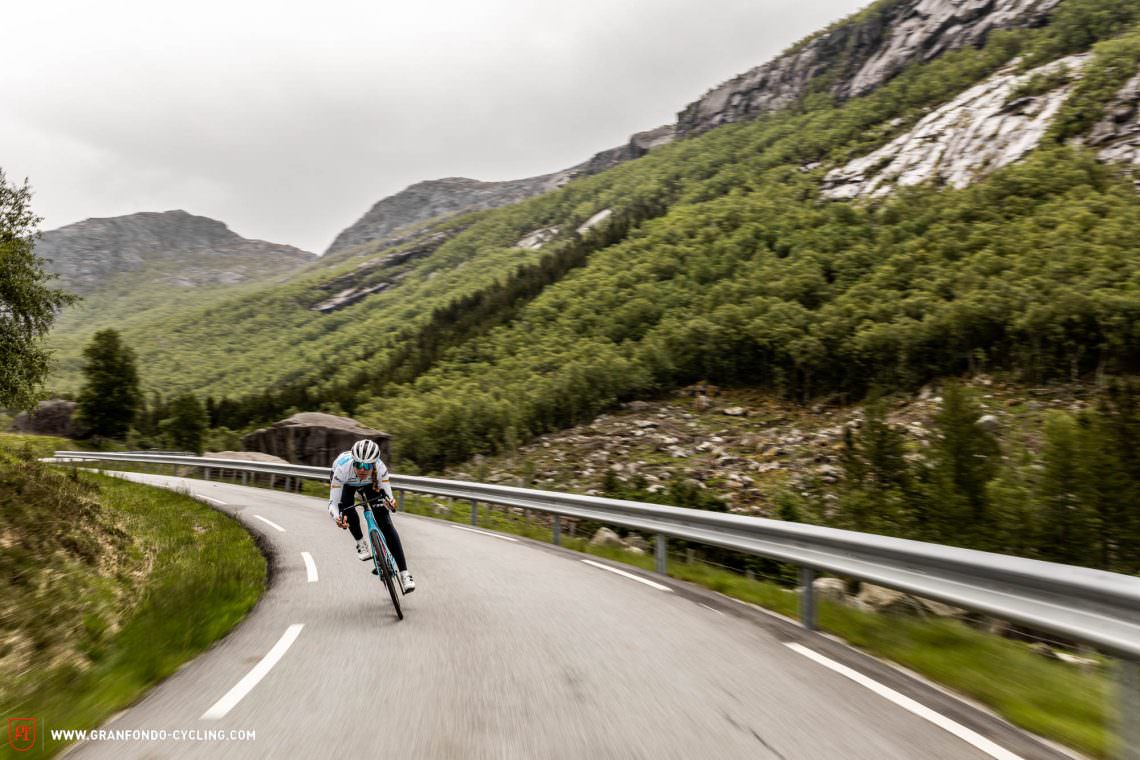
The 2023 Trek Madone SLR Disc is hot, and it looks damn fast. The improvements that Treks engineers have come up with also sound very promising, whether it’s for racing or a post-work ride. Its unique looks might be polarising, but we like it. We also like that Trek have tried to simplify the design, which is exactly what the IsoFlow system promises to do. We’ll have to wait until we’re able to put it to the test to find out if the all-new Madone is as fast and comfortable as promised.
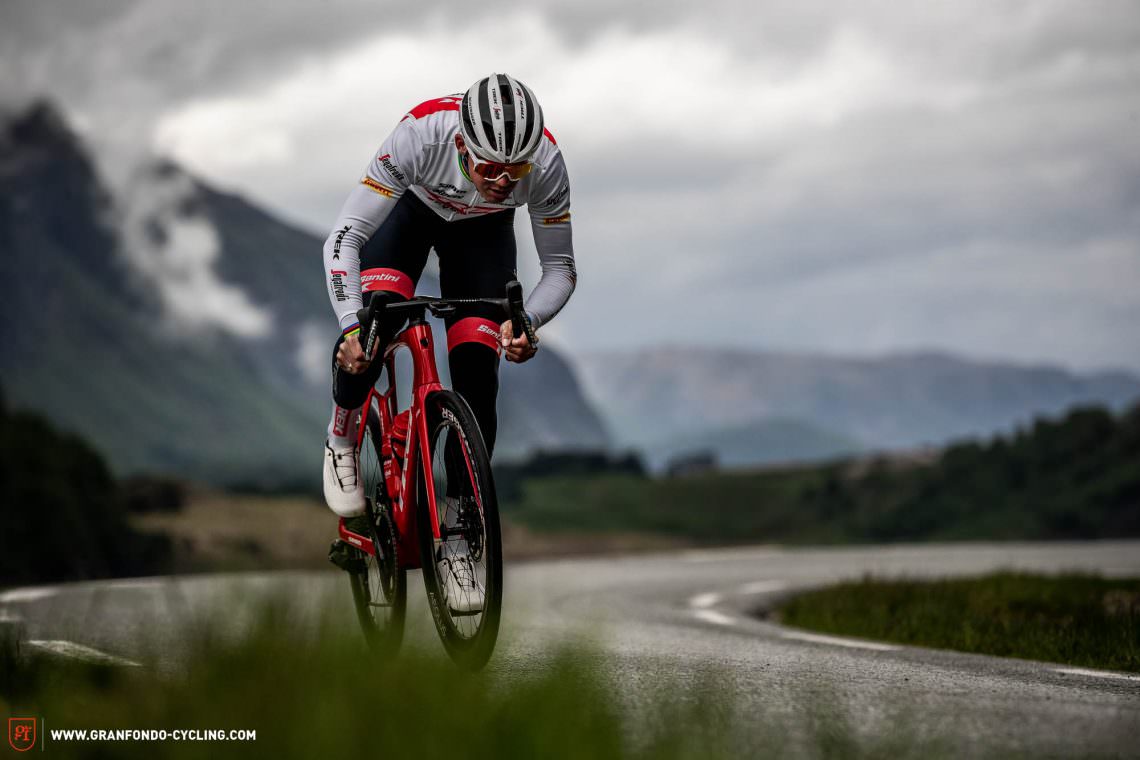
Did you enjoy this article? If so, we would be stoked if you decide to support us with a monthly contribution. By becoming a supporter of GRAN FONDO, you will help secure a sustainable future for high-quality cycling journalism. Click here to learn more.
Words: Simon Hänle Photos: Manufacturer


